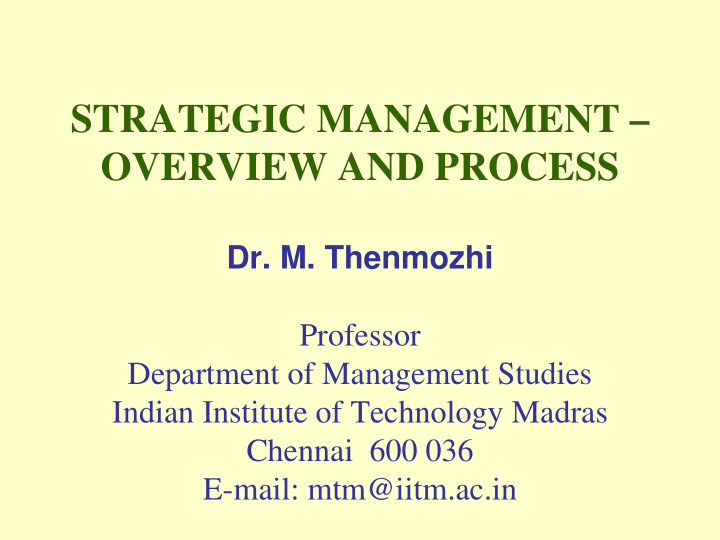



STRATEGIC MANAGEMENT – OVERVIEW AND PROCESS Dr. M. Thenmozhi Professor Department of Management Studies Indian Institute of Technology Madras Chennai 600 036 E-mail: mtm@iitm.ac.in
WHICH IS THE SUCCESSFUL STRATEGY? • Microsoft’s Business Model – sell proprietary code & give service free • Redhat Linux’s Business Model - source code open and free to all & technical support for a fee
RAYMONDS ACQUIRED COLORPLUS • Strengthen Formal + casual segment • Follow multiple brands strategy of Madura Garments • Position as complete men’s wear company – Park avenue=mid/premium formal wear Colorplus- premium smart casuals Parx – value for money casuals Manzoni- super premium shirts/suits
TATA CHEMICALS SODA ASH PLANT • Outsourcing its IT infrastructure- • Core activity Vs. Support functions • Competency analysis • Outsource to win strategy
DR. REDDY’ LAB - STRATEGY • Major focus on discovery of new chemical entities • R&D expenditure – 8% of sales in 2003 • Focus areas : diabetes, anti-cancer, non-sterodial anti-infectives, anti- inflammatories • Progress – licensed two anti-diabetis molecules to Novo Nordisk, five molecules in pipeline
WHICH STRATEGY IS SUCCESSFUL? • Create the future • Unlearn the past • Manage present
HOW COMPANIES REACT TO ENVIRONMENT? • Analyse the external and internal environment and evolve a strategy for implementation- proactive or reactive.
STRATEGIC MANAGEMENT - NEED Preliberalized regulated economy Liberalisation, Globalisation and Privatisation Need for greater strategic thinking felt
CHANGING ENVIRONMENT
CHARACTERISTICS OF SECOND AND THIRD WAVE Second wave Third wave Standardisation Destandarisation Specialisation Despecialisation Synchronisation Spontaneous Concentration Segmentation Maximisation Appropriate Scale Centralisation Decentralisation
GLOBAL MEGA TRENDS � Economic considerations transcending political considerations � The movement of world wide – wide free trade � The power full drive of telecommunications � The relative abundance of natural resources � Competition for reduced taxes � The Asian consumer boom � The advancement of democracy and the spread of free enterprise � Inflation and interest containment � The triumph of individual
ASIAN MEGA TRENDS From To 1. Nation States Network 2. Export led Consumer driven 3. Western influence The Asian way 4. Govt. Controlled Market driven 5. Villages Super cities 6. Labor intensive High technology 7. Male domination Emergence of woman 8. West East
Globalisation Technological Market Changes Changes Liberalisation Changing environment of organisations: Principal Constituents
Environmental Changes and Strategic response of organisation Portfolio Related Strategic Response Process Related Strategic • Mergers, Acquisition & Takeovers Responses • Demergers • Diversification • Quality Strategies • Share Buyback • International Quality • Divestiture/Disinvestments • Certification Programmes • Joint Venture • Just-in-time (JIT) Inventory • Strategic Alliances/collaborations • Benchmarking • Building Core Competence • Setting Vision & Mission Globalisation • Cost & Asset Utilisation Market changes Liberalisation Strategies Environment • Technological Upgradation & Organisation Indigenisation Technological Changes • Information Technology • Research & Development Structure Related strategic • Marketing Strategies Response • Project Management • Strategic Business Units • Matrix Structure • Delayering/ Flat Organisation Structure
WHAT IS STRATEGIC MANAGEMENT? • Strategy – greek word ‘strategos’ – generalship • Activities concerned with formulation and implementation of strategies to achieve organisational objectives
ESSENCE OF STRATEGIC MANAGEMENT • Assess where are we now ? • Identify where do we want to be? • Generate options on how we might get there? • Evaluate the options to identify which way is best? • Ensure we reach the desired position.
• STRATEGIC MANAGEMENT PROCESS
STRATEGIC MANAGEMENT PROCESS ENVIRONMENTA STRATEGY STRATEGY EVALUATION L SCANNING FORMULATIO IMPLEMENTATIO CONTROL N N External Internal Missions Objectives Strategies policies Programs Budgets Procedures Performance Feedback / Learning
ENVIRONMENTAL SCANNING External: Societal, Technological, economic, regulatory,competitive environment- PEST analysis ETOP analysis Industry Analysis- Porter’s Model, Strategic groups Internal: Organisational Capabalitiy analysis- SWOT, TOWS matrix, Value Chain analysis Organisation Structure Culture (Belief, expectation, Values) Resources (Assets, skills, competencies, BACK knowledge)
STRATEGY FORMULATION Mission Reason for existence Objectives What results to accomplish when Strategies Plan to achieve the mission & objective Policies Broad guidelines BACK for decision making
STRATEGY IMPLEMENTATION Programs Activities needed to accomplish a plan BACK Budgets Cost of the Program Procedures Sequence of steps needed to do the job
EVALUATION AND CONTROL Process to monitor performance and take corrective action •Performance BACK
STRATEGY FORMULATION Development of long range plans for effective management of environmental opportunities and threats in the light of corporate strengths and weaknesses.
DIVERSIFIED COMPANY 3 LEVELS OF STRATEGY Corporate-Level Strategy Growth of business as a whole Business-Level Strategy Division/business unit/product level Functional-Level Strategy support corporate & business level strategy
STRATEGIC CHOICES Understanding the bases for future strategy at both corporate and business unit levels and the options open for developing strategy in terms of both • Corporate level – Highest level and is concerned with the scope of an organisation’s strategies and the adding of value through its relationship with the separate parts of the business and the synergies created between these parts • Business level – The competitive advantage that is created from the understanding of both markets and customers based on specific competences • Directions and methods – How an organisation develops in terms of feasibility and acceptability
STRATEGY INTO ACTION This is where strategies are working in practice • Structuring – structure in terms of processes, boundaries and relations and their interactions • Enabling – Creation of support mechanisms in the organisation in order to support strategy implementation and development • Change – Creating an environment that facilitates change throughout the organisation
Recommend
More recommend